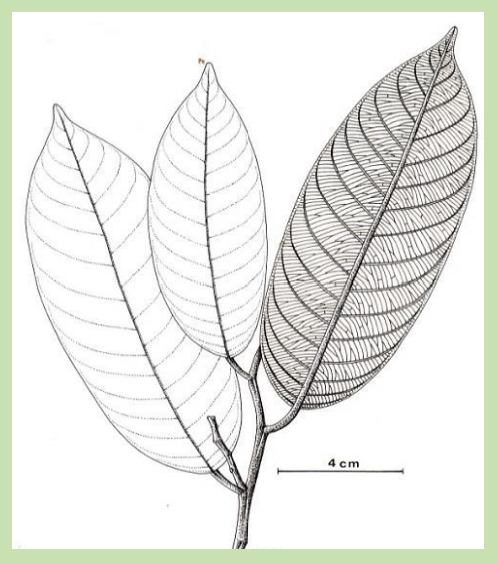Ecological aspects of meranti kunyit (Shorea macroptera Dyer) in Rantau Bertuah Forest, Siak Regency, Riau Province and the implication for forest management and conservation

Downloads
Downloads
Abunie, A.A, & Dalle, G. (2018). Woody species diversity, structure, and regeneration status of Yemrehane Kirstos Church Forest of Lasta Woreda, North Wollo Zone, Amhara Region, Ethiopia. International Journal of Forestry Research.
Andewi, B.A., & Dewantara, I. (2015). Struktur dan komposisi vegetasi di areal Petak Ukur Permanen (PUP) PT. Kawedar Wood Industry Kabupaten Kapuas Hulu. Jurnal Hutan Lestari, 3(1), 150-159.
Arbainsyah., De longh, H.H., & Kustiawan, W. (2014). Structure, composition, and diversity of plant communities in FSC-certified, selectively logged forests of different ages compared to primary rain forest. Biodeversity Conservation, 23, 2445-2472.
Ashton, P.S. (1982). Dipterocarpaceae. Flora Malesiana 9: 237–552. Hague, Netherland: Martinus Nijhoff Publishers.
Ashton, P.S. (2004). Dipterocarpaceae. In E. Soepadmo, L. G Saw, & R. C. K. Chung (Eds.), Tree Flora of Sabah and Sarawak (vols. 5). Kuala Lumpur, Malaysia: Ampang Press Sdn.Bhd.
Beech, E., Rivers, M., Oldfield, S., & Smith, P.P. (2017). GlobalTreeSearch: The first complete global database of tree species and country distributions. Journal of Sustainable Forestry, 36(5), 454-489.
Bismark, M., Subiandono, E., & Heriyanto, N.M. (2008). Keragaman dan potensi spesies serta kandungan karbon hutan mangrove di Sungai Subelen Siberut. Jurnal Penelitian Hutan dan Konservasi Alam, 5(3), 297–306.
Clatterbuck, W.K., Stringer, J.W., & Tankersley, L. (2011). PB1798 Uneven-age Management in Mixed Species, Southern Hardwoods: Is It Feasible and Sustainable?
Dharmawan, I.W.S., & Samsoedin, I. (2012). Dinamika potensi biomassa karbon pada landskap hutan bekas tebangan di Hutan Penelitian Malinau. Jurnal Penelitian Sosial dan Ekonomi Kehutanan, 9(1), 12–20.
Djarwanto, Damayanti, R., Balfas, J., Basri, E., Jasni., Sulistinngsih, I.M., … & Sopandi, A. (2017). Pengelompokan Jenis Kayu Perdagangan Indonesia. Bogor, Indonesia: FORDA Press.
Duncker, P. S., Barreiro, S. M., Hengeveld, G. M., Lind, T., Mason, W. L., Ambrozy, S., & Spiecker, H. (2012). Classification of forest management approaches: a new conceptual framework and its applicability to European forestry. Ecology and Society, 17(4), 51.
Erly, H., Wulandari, C., Safe’i, R., Kaskoyo, H., and Winarno, G. D. 2019. Keanekaragaman jenis dan simpanan karbon pohon di Resort Pemerihan, Taman Nasional Bukit Barisan Selatan. Jurnal Sylva Lestari 7(2), 139–149.
Harfoot, M. B., Newbold, T., Tittensor, D. P., Emmott, S., Hutton, J., Lyutsarev, V., ... & Purves, D. W. (2014). Emergent global patterns of ecosystem structure and function from a mechanistic general ecosystem model. PLoS biology, 12(4), e1001841.
Heriyanto, N.M., Samsoedin, I., & Kartawinata, K. (2019a). Tree species diversity, structural characteristics and carbon stock in a one-hectare plot of the protection forest area in West Lampung Regency, Indonesia. Reinwardtia, 18(1), 1-18.
Heriyanto, N.M., Samsoedin, I., & Bismark, M. (2019b). Biodiversity flora and fauna in the region forest Bukit Datuk Dumai Riau Province. Jurnal Sylva Lestari, 7(1), 82-94.
Jew, E.K., Dougill, A.J., Sallu, S.M., O’Connell, J., & Benton, T.G. (2016). Miombo woodland under threat: Consequences for tree diversity and carbon storage. Forest Ecology and Management, 361, 144-153.
Kartawinata, K. (2013). Diversitas Ekosistem Alami Indonesia. Jakarta, Indonesia: Yayasan Pustaka Obor Indonesia.
Kusmana C., & Hikmat, A. (2015). The biodiversity of flora in Indonesia. Jurnal Pengelolaan Sumberdaya Alam dan Lingkungan, 5(2), 187-198.
Lang, J.M. & Benbow, M.E. (2013) Species interactions and competition. Nature Education Knowledge, 4(4), 8.
Ludwig, J.A., & Reynolds, J.F. (1988). Statiscal Ecology, Aprumer on Methods and Computing. New York, USA: John Wiley & Sons.
Magurran, A.E. (2004). Measuring Biological Diversity. Malden M.A, USA: Blackwell Publising.
Maua, J.O., MugatsiaTsingalia, H., Cheboiwo, J., & Odee, D. (2020). Population structure and regeneration status of woody species in a remnant tropical forest: A case study of South Nandi Forest, Kenya. Global Ecology and Conservation, 21, e00820.
Medjibe, V.P., & Putz, F.E. (2012). Cost comparisons of reduced-impact and conventional logging in the tropics. Journal of Forest Economics, 18(3), 242-256.
Mueller-Dombois, D., & Ellenberg, H. (1974). Aims and Methods of Vegetation Ecology. Wiley.
Mueller-Dombois, D., & Ellenberg, H. (2016). Ekologi Vegetasi. Jakarta, Indonesia: LIPI Press.
Muhdi, M., Elias, E., Murdiyarso, D., & Matangaran, J.R. (2012). Kerusakan tegakan tinggal akibat pemanenan kayu reduced impact logging dan konvensional di hutan alam tropika (Studi kasus di areal Iuphhk PT. Inhutani II, Kalimantan Timur) (Residual stand damage caused by conventional and reduced impact logging). Jurnal Manusia dan Lingkungan, 19(3), 303-311.
National Parks Board. (2016). Heritage Trees: Meranti. Retrived from https://www.nparks.gov.sg/.
Newman, M.F., Barstow, M., & Pooma, R. (2017). Shorea macroptera. The IUCN Red List of Threatened Species. Retrived from https://www.iucnredlist.org/.
Pulan, D.E., & Buot, Jr.I.E. (2014). Leaf Architecture of Philippine Shorea species (Dipterocarpaceae). International Research Journal Biological Science, 3(5), 19–26.
Pusat Penelitian Tanah dan Agroklimat. 1993. Peta Tanah Pulau Sumatera. Bogor, Indonesia: Author.
Rahmah., K. Kartawinata., Nisyawati., Wardhana & E. Nurdin. (2016). Tree species diversity in the lowland forest of the core zone of the Bukit Duabelas National Park, Jambi, Indonesia. Reinwardtia 15(1), 11-26.
Sadili, A., Kartawinata, K., Soedjito, H & E. Sambas. (2018). Tree species diversity in a pristine montane forest previously untouched by human activities in Foja Mountains, Papua, Indonesia. Reinwardtia 17(2), 133-154.
Schmidt, F.H., & Fergusson, J.H.A. (1951). Rain Fall Type Based on Wet and Dry Period Ratios for Indonesia with Western New Guinea Verh. No 42. Jakarta, Indonesia: Direktorat Meteorologi dan Geofisika.
Senbeta, F., Schmitt, C., Woldemariam, T., Boehmer, H. J., & Denich, M. (2014). Plant diversity, vegetation structure and relationship between plant communities and environmental variables in the Afromontane Forests of Ethiopia. SINET: Ethiopian Journal of Science, 37(2), 113-130.
Soerianegara, I., & Lemmens, R.H.M.J. (2002). Sumber Daya Nabati Asia Tenggara 5 (1): Pohon penghasil kayu perdagangan yang utama. Jakarta, Indonesia: PROSEA-Balai Pustaka.
Soewandita, H., & Sudianan, N. (2011). Analisis potensi dan karakteristik gambut sebagai bahan pertimbangan untuk arahan perencanaan pengembangan kawasan di Kabupaten Siak. Jurnal Sains dan Teknologi Indonesia, 13(2), 130-136.
Subiakto, A., Rachmat, H.H., & Wijaya, K. (2016). Dipterocarps: Walk through the remnant forest in Riau, Sumatra. Bogor, Indonesia: Forda Press.
Subiandono, E., Bismark, M., & Heriyanto, N.M. (2013). Kemampuan Avicennia marina (Forsk.) Vierh. dan Rhizophora Apiculata Bl. dalam penyerapan polutan logam berat. Jurnal Penelitian Hutan dan Konservasi Alam 9(1), 93-102.
Symington, C.F., Ashton, P.S., Appanah, S., & Barlow, H.S. (2004). Foresters’ Manual of Dipterocarps (2nd ed.). Kuala Lumpur, Malaysia: Forest Research Institute Malaysia.
The Plant List. (2013). The Plant List (vers. 1.1). Kew, UK and Missouri, USA: Royal Botanic Garden and Missouri Botanical Garden.
Tinya, F., Kovács, B., Aszalós, R., Tóth, B., Csépányi, P., Németh, C., & Ódor, P. (2020). Initial regeneration success of tree species after different forestry treatments in a sessile oak-hornbeam forest. Forest Ecology and Management, 459, 117810.
United Nations Environment Programme. (2021). Becoming #GenerationRestoration: Ecosystem restoration for people, nature and climate. Nairobi.
Wardani, M., & Heriyanto, N. M. (2015). Autekologi Damar Asam Shorea hopeifolia (F. Heim) Symington di Taman Nasional Bukit Barisan Selatan, Lampung. Buletin Plasma Nutfah, 21(2), 89-98.
Wardani, M., Astuti, I.P., & Heriyanto, N.M. (2017). Analisis vegetasi spesies-spesies Dipterocarpaceae di Kawasan Hutan Seksi I Way Kanan, Taman Nasional Way Kambas, Lampung. Buletin Kebun Raya, 20(1), 51–64.
Wardani, M. (2017). In T. Kalima, & I. Samsoedin (Eds.). Pengenalan jenis meranti (Shorea Spp.) melalui morfologi daun. Bogor, Indonesia: FORDA Press.








